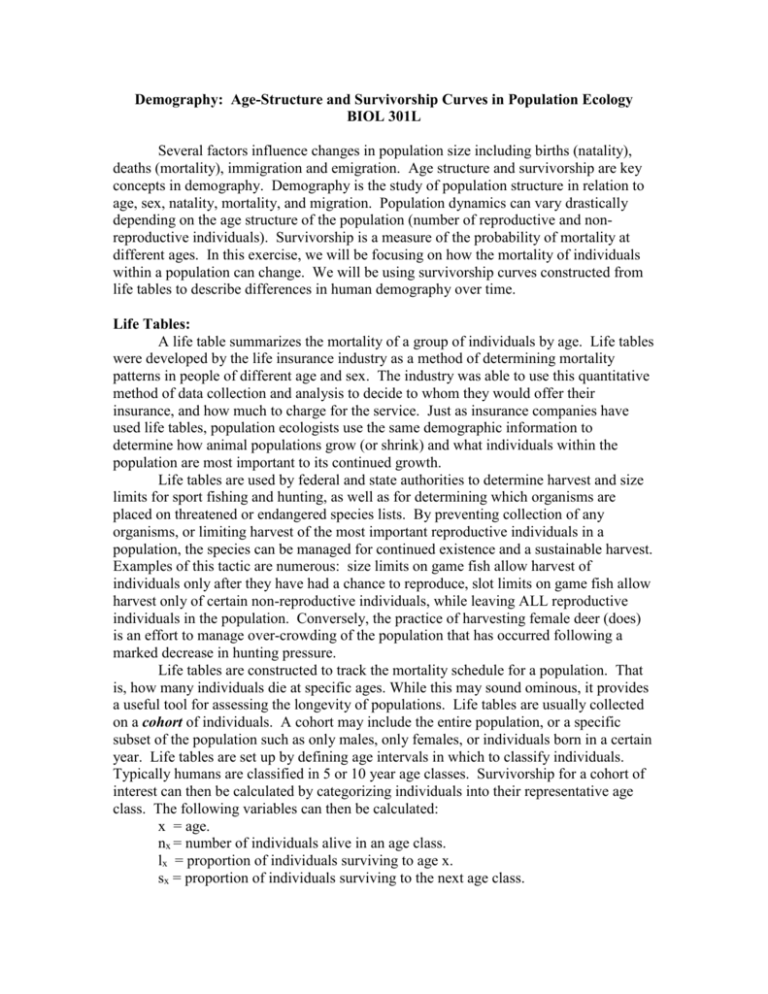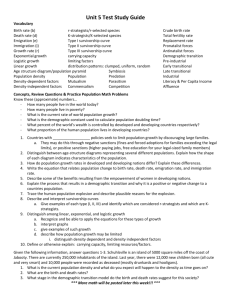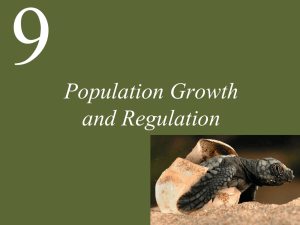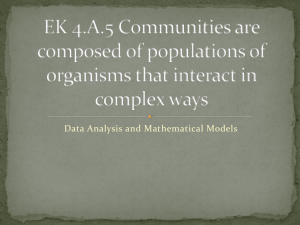Age-Structure and Survivorship Curves in Population Ecology
advertisement

Demography: Age-Structure and Survivorship Curves in Population Ecology BIOL 301L Several factors influence changes in population size including births (natality), deaths (mortality), immigration and emigration. Age structure and survivorship are key concepts in demography. Demography is the study of population structure in relation to age, sex, natality, mortality, and migration. Population dynamics can vary drastically depending on the age structure of the population (number of reproductive and nonreproductive individuals). Survivorship is a measure of the probability of mortality at different ages. In this exercise, we will be focusing on how the mortality of individuals within a population can change. We will be using survivorship curves constructed from life tables to describe differences in human demography over time. Life Tables: A life table summarizes the mortality of a group of individuals by age. Life tables were developed by the life insurance industry as a method of determining mortality patterns in people of different age and sex. The industry was able to use this quantitative method of data collection and analysis to decide to whom they would offer their insurance, and how much to charge for the service. Just as insurance companies have used life tables, population ecologists use the same demographic information to determine how animal populations grow (or shrink) and what individuals within the population are most important to its continued growth. Life tables are used by federal and state authorities to determine harvest and size limits for sport fishing and hunting, as well as for determining which organisms are placed on threatened or endangered species lists. By preventing collection of any organisms, or limiting harvest of the most important reproductive individuals in a population, the species can be managed for continued existence and a sustainable harvest. Examples of this tactic are numerous: size limits on game fish allow harvest of individuals only after they have had a chance to reproduce, slot limits on game fish allow harvest only of certain non-reproductive individuals, while leaving ALL reproductive individuals in the population. Conversely, the practice of harvesting female deer (does) is an effort to manage over-crowding of the population that has occurred following a marked decrease in hunting pressure. Life tables are constructed to track the mortality schedule for a population. That is, how many individuals die at specific ages. While this may sound ominous, it provides a useful tool for assessing the longevity of populations. Life tables are usually collected on a cohort of individuals. A cohort may include the entire population, or a specific subset of the population such as only males, only females, or individuals born in a certain year. Life tables are set up by defining age intervals in which to classify individuals. Typically humans are classified in 5 or 10 year age classes. Survivorship for a cohort of interest can then be calculated by categorizing individuals into their representative age class. The following variables can then be calculated: x = age. nx = number of individuals alive in an age class. lx = proportion of individuals surviving to age x. sx = proportion of individuals surviving to the next age class. From these values, survivorship curves for a given cohort can then be constructed. 100 90 80 70 60 50 40 30 20 10 0 Type 1 Type 2 81 -8 5 91 -9 5 71 -7 5 61 -6 5 51 -5 5 31 -3 5 41 -4 5 21 -2 5 Type 3 11 -1 5 05 Proportion of survivors (l x) Hypothetical Survivorship Curves Age Class The above figure displays three general survivorship curves for a given population. A type 1 curve describes a population that has a high rate of survivorship (low mortality) until later in life. Many mammals (including homo sapiens) are classified by a type 1 curve. A type 2 curve describes a population in which survivorship is relatively independent of age. Many species of birds are characterized by a type 2 curve. A type 3 curve describes a population that has low survivorship (high mortality) at relatively young ages. Species that produce a large number of offspring, and provide little parental care are characteristic of a type 3 curve, including many insects, fish, and plants. It is important to remember that these are hypothetical survivorship curves, and that many populations (if not most) may deviate from these theoretical survivorship curves. Example: One of the first applications of life table data applied to ecology involved the study of patterns of survival among Dall sheep (Ovis dalli) in Alaska. Ecologist Adolf Murie collected skulls of 608 sheep that died from various causes. Skulls were categorized into age classes based on growth rings on horns and tooth wear. Below is the life table constructed from this data and the survivorship curve (lx vs. age). Table 1: Life table for Murie Dall sheep skulls Age 0 1 2 3 4 5 6 7 8 9 10 11 12 13 14 Number dying 121 7 8 7 18 28 29 42 80 114 95 55 2 2 0 Number alive 608 487 480 472 465 447 419 390 348 268 154 59 4 2 0 lx sx 1 0.801 0.789 0.776 0.765 0.734 0.688 0.64 0.571 0.439 0.252 0.096 0.006 0.003 0 0.801 0.986 0.983 0.985 0.961 0.937 0.931 0.892 0.77 0.575 0.383 0.068 0.5 0 0 Lx (proportion of survivors) Figure 1: Dall sheep survivorship curve 1 0.9 0.8 0.7 0.6 0.5 0.4 0.3 0.2 0.1 0 1 2 3 4 5 6 7 8 9 10 11 12 13 14 15 Age (years) Laboratory Exercise: Today, we will visit Trinity Episcopal Church and collect data for a cohort of individuals born before 1850. We will then come back to the lab and collect data for a second cohort born after 1900. Finally we will create life tables and survivorship curves to explore differences in survivorship between males and females, and between those born in the 19th and 20th centuries.








